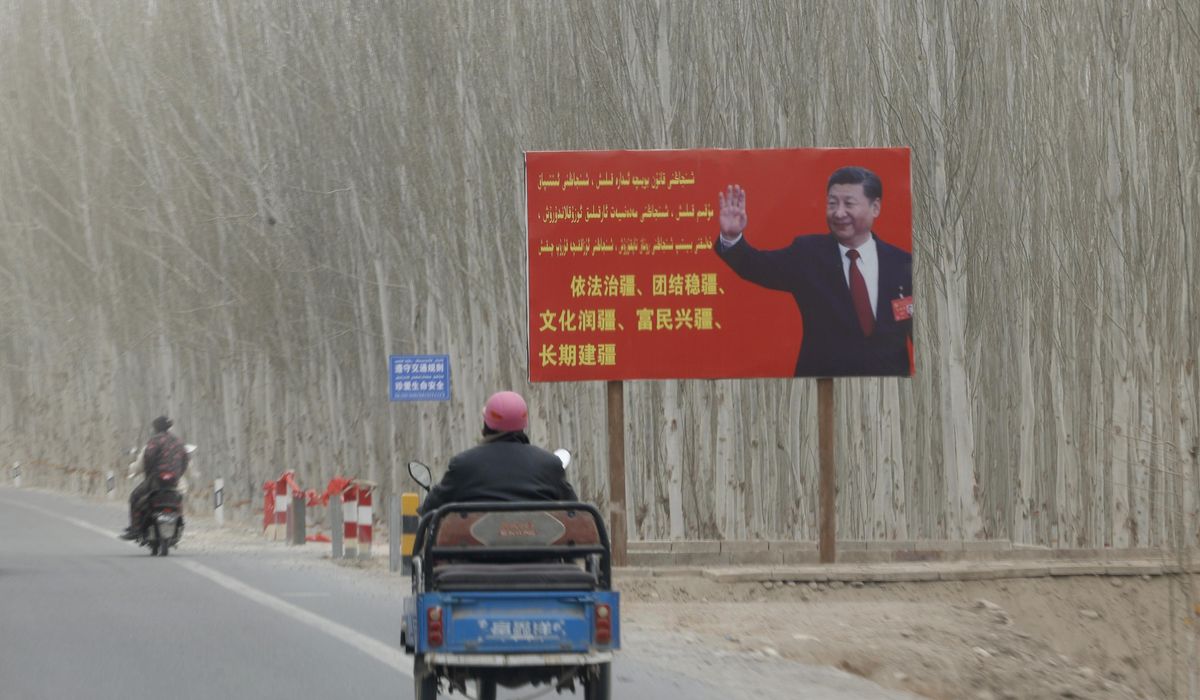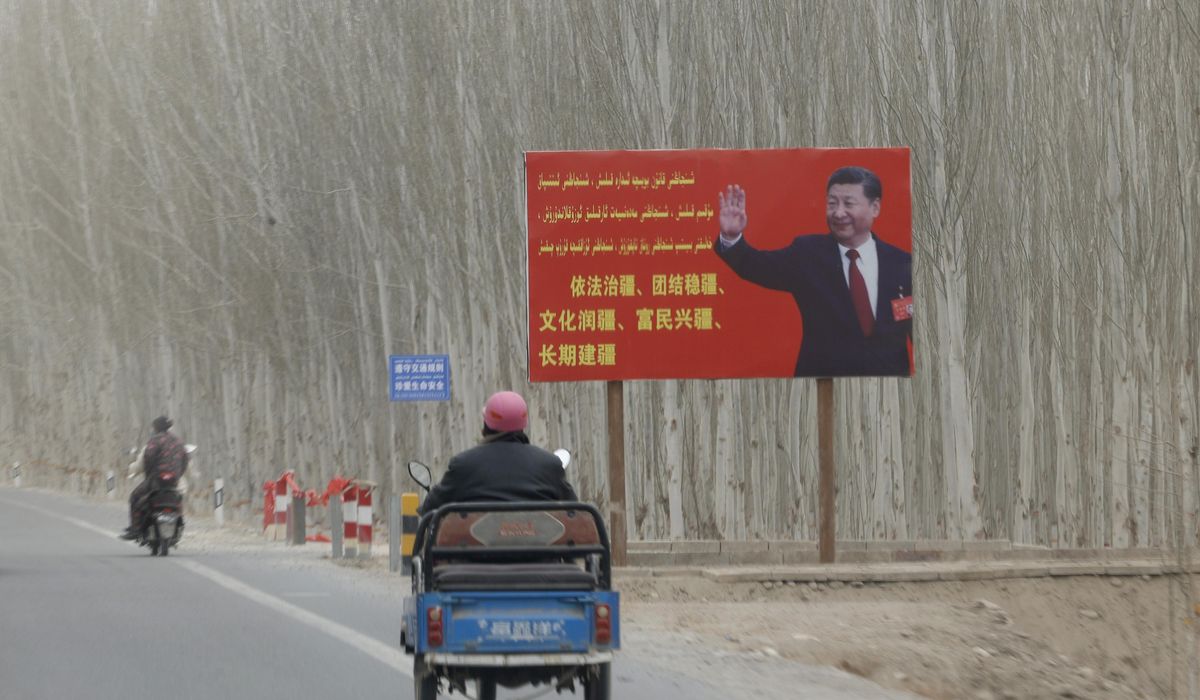
BANGKOK — Silk Road travelers in ancient times cursed China’s largest desert as “Takla Makan,” an ominous Persian-Turkic expression that translates as, roughly, “Enter and you may never return.”
Undeterred by the sandstorms and merciless terrain in the oblong basin north of Tibet’s glacier-packed peaks, Chinese engineers have announced the completion of the final section of a Taklamakan Desert railway loop line, billed as the world’s first to encircle a desert.
Trains have emerged as a central component of the communist leadership’s push for domestic control and foreign influence. A train link to the remote Tibetan capital of Lhasa was hailed as a key step in connecting the restive region to the rest of China, and rail-building projects are featured in a number of Chinese President Xi Jinping’s Belt and Road program of international infrastructure support.
At home, China is constructing maglev train systems capable of hurtling passengers and freight hundreds of miles per hour. An underwater route near Shanghai will reach tiny offshore islands.
The latest railway system has become a talking point for China’s military, industrial, agricultural and political prowess in the state-controlled press. Meanwhile, the Biden administration is struggling to get its own major infrastructure bill passed through a reluctant Congress.
The Taklamakan Desert railway loop fits the pattern of strategic rail lines for Beijing, allowing for greater access to rebellious Kashgar, a distant southwestern city near vulnerable borders with India, Pakistan, Afghanistan and Kyrgyzstan. Kashgar and elsewhere in Xinjiang province contain a large population of restive Muslim Uyghurs of ethnic Turkic origin. Their treatment by the central government has been harshly condemned by the U.S. and other Western governments, as well as by private human rights groups.
Official Chinese accounts offer a far blander explanation. They say the rail line will help bring economic development to one of the country’s poorest regions.
“With a designed speed of [72 miles per hour], the fully completed railway line is expected to slash travel time between Hotan prefecture in Xinjiang and Xining, capital of Northwest China’s Qinghai Province, from three days to just one,” China’s official cable TV network CGTN recently reported. “The project will bring rail service to five counties in Southern Xinjiang and integrate Southern Xinjiang into a vast network of railways along Belt and Road routes.”
Beijing denies widespread reports that its security forces imprison Uyghurs in detention camps scattered across Xinjiang to erase suspected extremist Islamist beliefs, politics and behavior. The Trump and Biden administrations have said the overall campaign to repress Uyghurs and increase the population of Han Chinese in the region amounts to genocide.
Many Uyghurs dream of escaping Chinese control and want closer relations with ethnic and linguistic brethren in Central Asia’s Turkic-speaking nations, with Turkey as their beacon.
Last year, international democracy activists boycotted Disney’s movie “Mulan,” starring dual U.S.-Chinese citizen Liu Yifei, after the company thanked China’s Bureau of Public Security for help with filming in the Taklamakan Desert.
The railway loop also enables exploitation of the Tarim Basin oil field, estimated to cover 350,000 square miles under the Taklamakan’s huge dunes and shifting sands. From the oasis town of Hotan, an existing line continues to Kashgar.
“Workers tighten[ed] the screw of the rail” and finished the final Hotan-Ruoqiang link on Sept. 27, China’s official Xinhua News Agency announced.
This link is expected to start selling tickets in June, allowing the entire loop to encircle the Germany-sized Taklamakan, the world’s second-largest desert after the Sahara.
Beijing hails the Taklamakan loop as a way to help the region, especially Xinjiang’s impoverished southern edge near northern Tibet. That edge includes the existing Golmud-Korla Railway, which now joins the loop.
Other trains already go south from Golmud to Lhasa in Tibet. China envisions continuing those tracks south from Lhasa to Nepal’s capital, Kathmandu.
Deep history
The tracks pass over a rich history of cultivation and conquest, along with ancient trading routes that the Belt and Road program hopes to revive in modern form. More than 2,000 years ago, Bronze Age inhabitants buried mummies in the Taklamakan, according to a French-funded excavation.
As the desert expanded southward, ancient kingdoms crumbled into ruins or were buried.
These included the flourishing Loulan kingdom on vast Lake Lop Nur before its water evaporated in the fifth century. Buddhist monks trudged those routes spreading their godless religion east until medieval sea routes replaced hazardous overland treks to East Asia.
By constructing a railway around the desert, Chinese engineers re-created Silk Road caravan routes that linked China and Europe by skirting the Taklamakan’s rim. The route is flanked by the snowcapped Tian Shan range on the desert’s north and the Kunlun Mountains along its southern curve. Rugged Pamir peaks form its western ridge.
The railway had to cross, or route around, elevations up to 5,000 feet. “Grass grids” were laid across 165 million square feet of dunes that were virtually devoid of plant life, officials said.
They said 13 million seedlings were planted through anti-desertification programs.
In the harshest, most unpredictable zones — battered by sandstorms and smothered by swollen dunes — engineers designed lengthy bridges above chaotic sand.
Closer to Beijing, a maglev train project is starting in Shanxi, a north-central province. Magnets allow maglev train carriages to float without wheels.
“The high-speed train uses superconducting magnetic levitation technology to disengage from the ground to eliminate frictional drag,” Chinese engineering expert Ma Tiehua said, according to London-based Railway Technology news.
This maglev uses “a near-vacuum internal duct line to dramatically reduce air resistance, to achieve travel speeds of more than [620 mph],” Mr. Ma said.
China already boasts the world’s fastest commercial maglev on a 19-mile route in Shanghai, linking Shanghai Pudong International Airport to an urban metro system on the city’s edge within seven minutes, at up to 268 mph.
Nearby, a bullet train is preparing to zip under the sea at 155 mph. The U.K.-based website IFLScience reported in May that the project would be “the world’s first underwater bullet train.”








